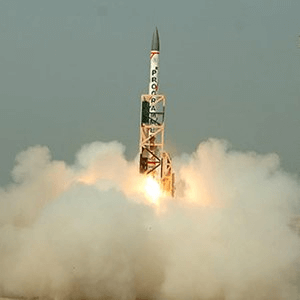What is the full form of ABMABM: Anti-Ballistic MissileABM stands for Anti-Ballistic Missile. It is a surface-to-air missile, specifically designed to intercept and counter ballistic missiles, i.e., a missile for missile defence. This term is also used for an antimissile system designed to counter ballistic missiles. However, generally, the missiles or systems designed to counter intercontinental ballistic missiles (ICBM) are known as ABM. 
India has also launched an Indian Ballistic Missile Defence Programme to develop a multi-layered ballistic missile defence system to protect the country from ballistic missile attacks. It is an initiative in response to the missile threats from some countries, mainly Pakistan. It is a double-tiered system which comprises land and sea-based interceptor missiles; the Prithvi Air Defence (PAD) missile for high altitude interception and the Advanced Air Defence (AAD) Missile for lower altitude interception. This system is supposed to be able to intercept missiles launched from a distance of 5,000 kilometers. It is also equipped with a network of radars for early warning and tracking and the command-and-control posts. The PAD was tested for its accuracy, range and impact in November 2006 and the AAD was tested in December 2007. After testing the PAD, India became the fourth country to have successfully developed an anti-ballistic missile system after the US, Russia and Israel. Some Popular Counter-ICBM systems/ABM
Indian Ballistic Missile Defence ProgrammeA multi-layered ballistic missile defence framework is being created and conveyed as a component of the Indian Ballistic Missile Defense Program to guard India against long-range rocket attacks. Phase 1 has been examined and finished successfully, and deployment is awaiting final official approval. Phase 2 is still being created. The Prithvi Air Defence (PAD) rocket for higher altitude capture and the Advanced Air Defence (AAD) Missile for lower height interference make up this two-layered architecture, which is based on both land and sea. It was acquainted accordingly with the long-range rocket danger from Pakistan and China. Any approaching rocket sent off from 5,000 kilometres away ought to have the option to be captured by the two-layered safeguard. A network of early warning and following radars is likewise an important component of the framework. Anti-Ballistic Missile TreatyThe Treaty on the control of Anti-Ballistic Missile Systems, otherwise called the Anti-Ballistic Missile Treaty (ABM Treaty), is an arms control arrangement that the United States and the Soviet Union endorsed in 1972. Its motivation was to confine the arrangement of rocket frameworks that might actually be utilized to capture approaching intercontinental long-range rockets (ICBMs) sent off by the other superpower. The United States previously proposed exchanges to prohibit long-range rocket safeguards in 1966, yet they didn't begin until late 1969 as a component of the Strategic Arms Limitation Talks (SALT). At a meeting in Moscow in May 1972, U.S. President Richard Nixon and Soviet Premier Leonid Brezhnev marked the ABM Treaty. Soon thereafter, it was sanctioned by the U.S. Senate and the Supreme Soviet.
Next TopicFull Form
|
 For Videos Join Our Youtube Channel: Join Now
For Videos Join Our Youtube Channel: Join Now
Feedback
- Send your Feedback to [email protected]
Help Others, Please Share










